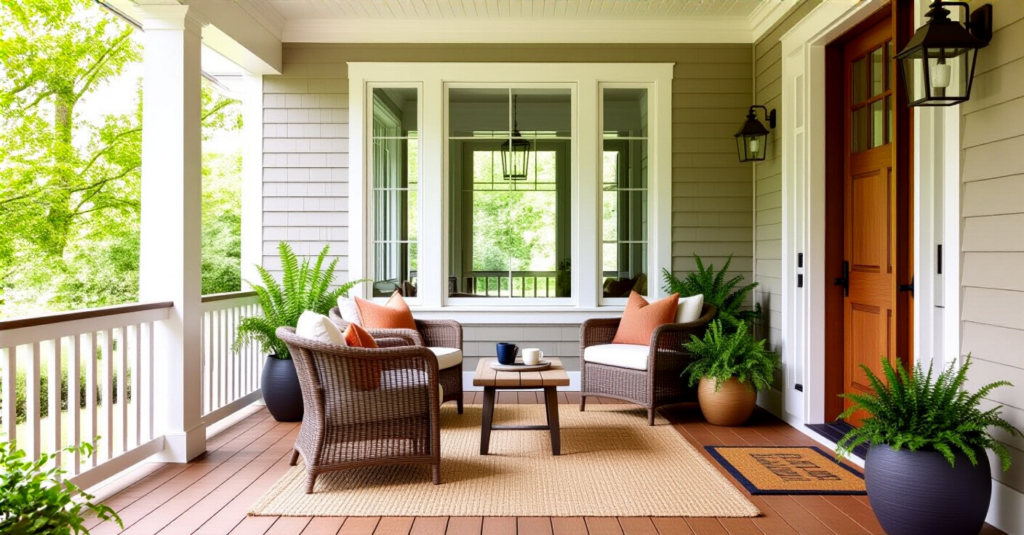You know what people always ask me? It’s not about paint colors or the most expensive furniture. They lean in close and ask, “Autumn, how do I make my porch feel like a real room? A place where my family will actually want to hang out, not just a walkway to the front door.” It’s the best question, because it gets right to the heart of what we all want: a cozy retreat, a place to take a deep breath, and a spot to make memories.
It’s about more than just adding a few chairs. It’s about creating that magical space where you can sip your morning coffee in peace, where the kids can have snacks without trailing crumbs through the house, and where you can unwind with a glass of wine after a long day. It’s an extension of your living room, the true heart of your home. So let’s forget the overwhelming, technical stuff for a minute. Let me walk you through how to create that little slice of outdoor heaven, your way.
Foundational Planning: Defining Your Porch’s Purpose & Placement
Before you even think about swinging a hammer or picking out pillows, we have to do a little daydreaming with a purpose. This is the part where we get really honest about how your family lives. It’s about setting the stage so that every single choice we make from here on out supports the cozy, comfortable life you want to live out there.
1. Define Your Porch’s Primary Function: Leisure, Dining, or Welcoming
Okay, first things first. Before we get lost in Pinterest, I want you to close your eyes and picture a perfect afternoon. What are you doing on this dream porch? Are you curled up on a deep, comfy sofa with a book and a blanket? Are you gathered around a table with friends, sharing a meal and lots of laughter? Or is it simply about creating a breathtakingly warm welcome, with beautiful planters and a charming spot for two? Be honest. If your family isn’t big on formal outdoor dinners, don’t design a porch around a massive dining table that will just end up collecting dust and pollen.
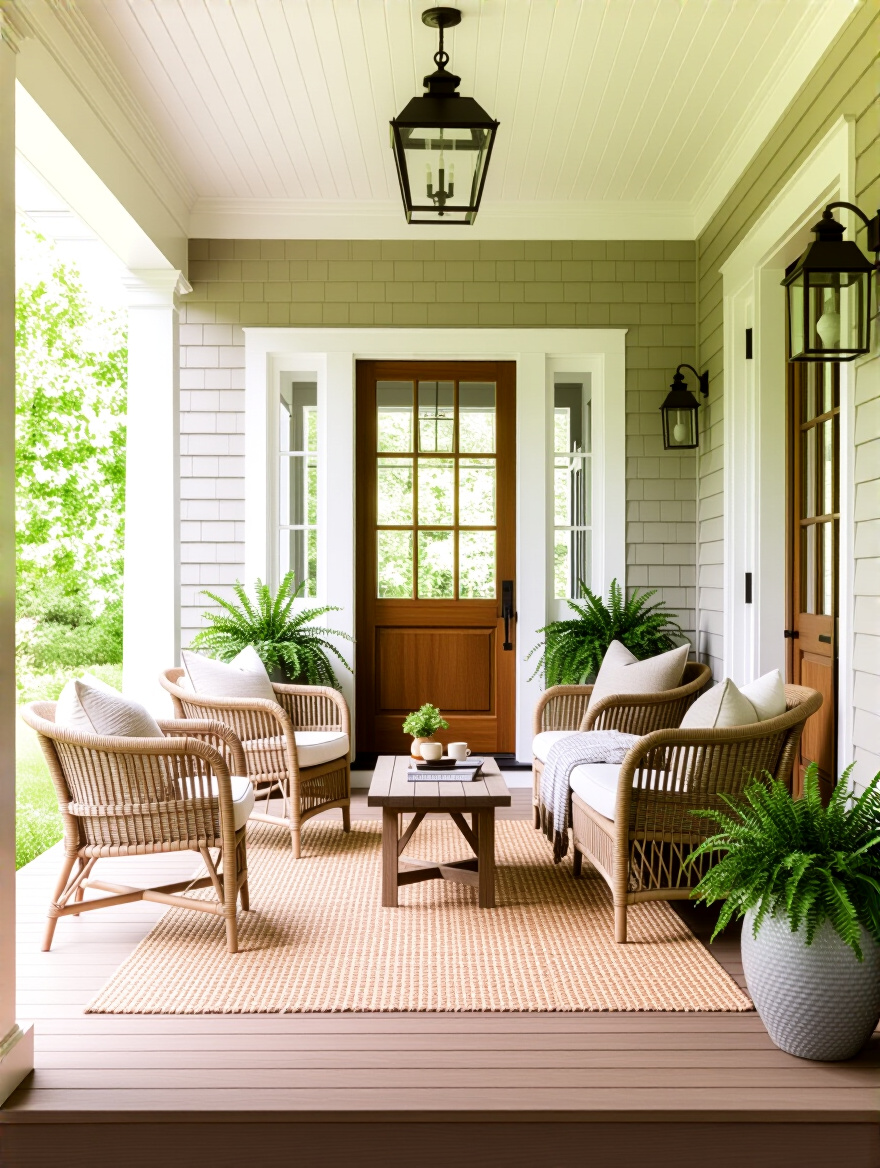
This one decision will guide everything else. A “lounging” porch needs deep, sink-in-and-stay-awhile seating. A “dining” porch needs enough space to pull out chairs and move around the table. A “welcoming” porch might just need a pretty bench and amazing lighting. I once had a client who was adamant about a huge dining set, but after we talked, we realized what she really wanted was a comfortable spot to watch her kids play in the front yard. We swapped the clunky table for a cozy outdoor sofa and two armchairs, and now it’s their most-used space. It’s all about designing for the life you actually have.
Now that you know what you’ll be doing out there, let’s make sure it looks like it truly belongs to your home.
2. Assess Your Home’s Architectural Style for Cohesive Design Harmony
There’s nothing that feels more out of place than a porch that looks like it was beamed down from another planet and stuck onto a house. A super modern, sleek porch on a historic Victorian? It just feels… off. The goal here is to make your new porch look like it was always there, a natural and beautiful part of your home’s story. Take a little walk outside and really look at your house. What are the key features? Is it a classic Colonial? A cozy Craftsman bungalow? A rambling Ranch?
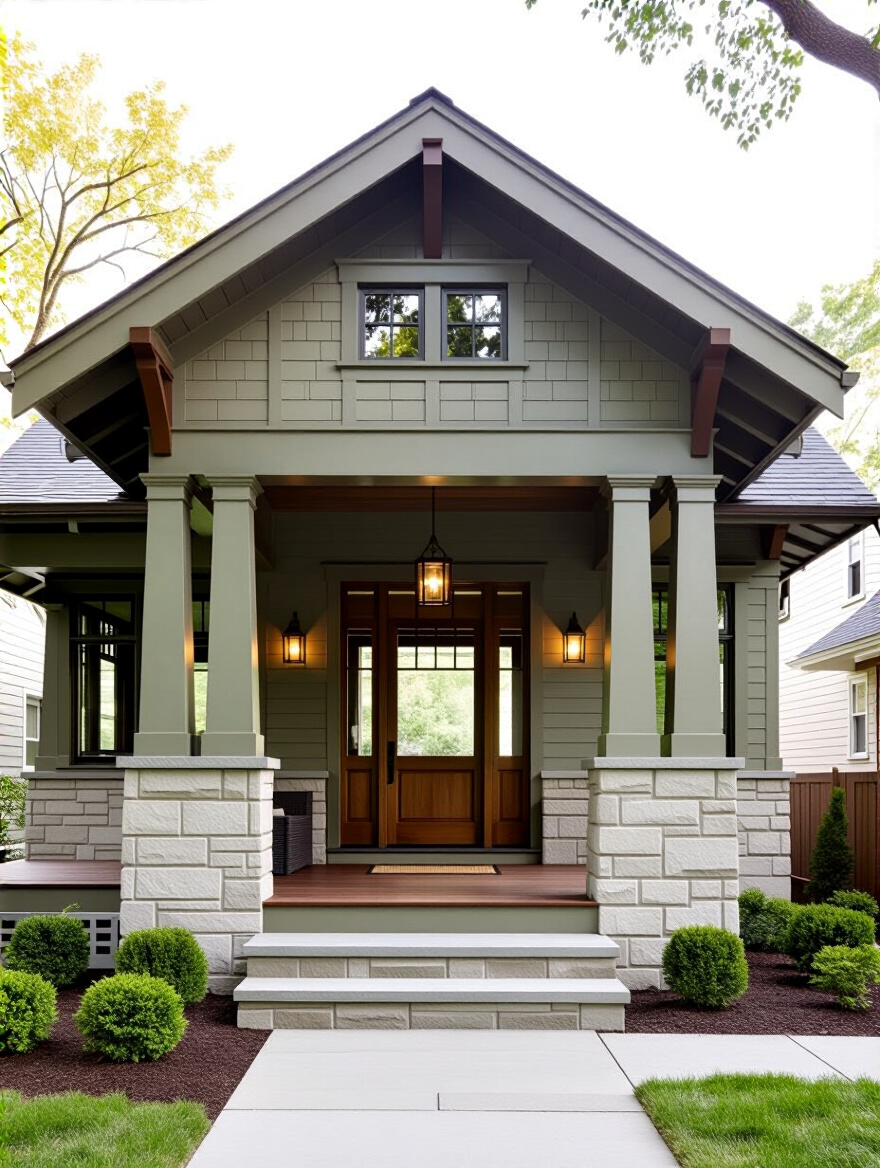
Look at the details—the pitch of your roof, the style of your windows, the trim, the materials. A Craftsman home begs for chunky, tapered columns and earthy stone accents. A farmhouse loves simple, clean lines and a metal roof. The idea isn’t to create a perfect historical replica (unless you want to!), but to borrow the home’s “language” so the porch speaks it fluently. It should echo the lines, the scale, and the materials of the main house. This little bit of homework ensures your porch enhances your home’s charm instead of distracting from it.
And of course, we need to talk about the budget before we get too carried away with those beautiful details.
3. Establish a Realistic Budget to Guide Material and Feature Choices
Let’s talk about money. It’s not the most fun part, but I promise, getting clear on your budget now will save you so much stress later. The biggest mistake I see people make is creating a grand vision without knowing what it will actually cost. It’s heartbreaking to have to scale back a dream project midway through because the funds have dried up. So, let’s be practical and make a plan that feels good.
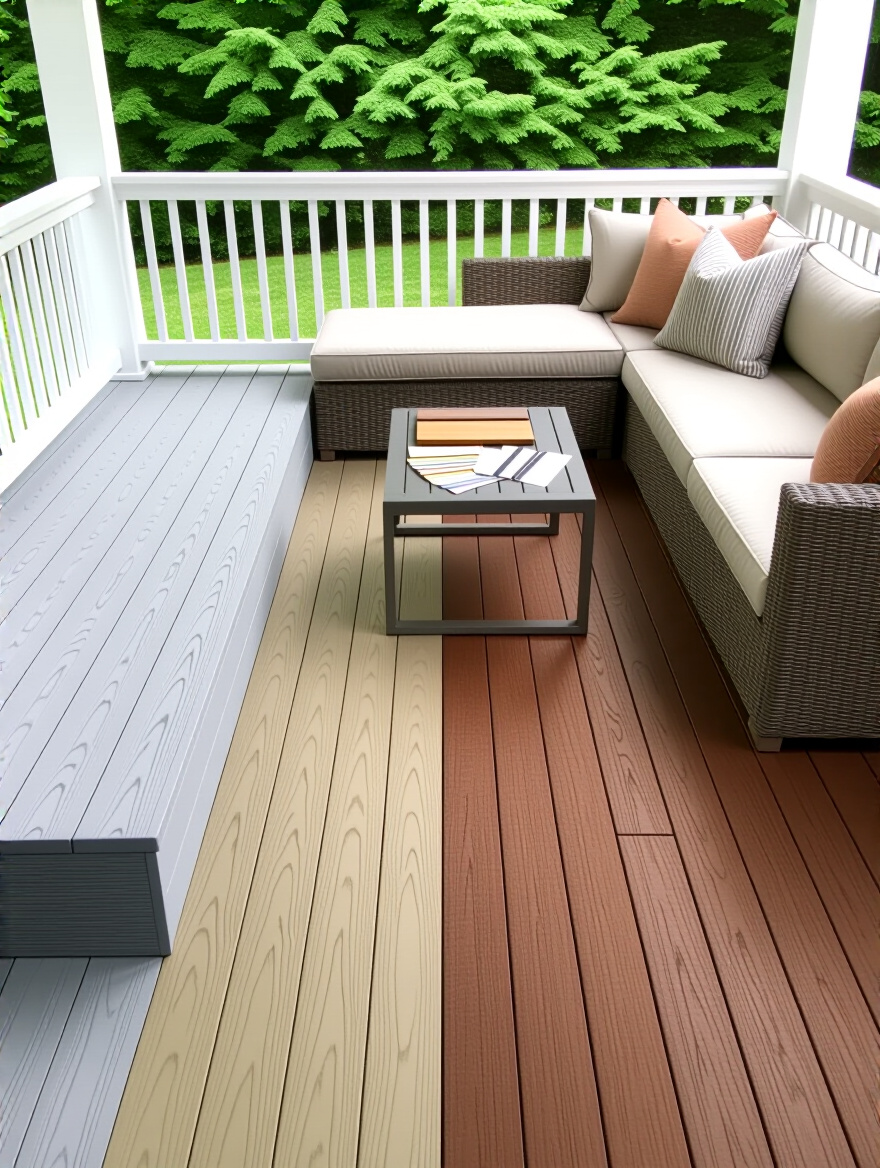
Start by doing some basic research on costs in your area for things like decking, railings, and labor. Then, make a list of everything—and I mean everything. The big stuff is obvious, but don’t forget the small things: permits, lighting fixtures, new outdoor outlets, furniture, planters, maybe even hiring an electrician. My best piece of advice? Whatever number you land on, add another 15-20% on top for a contingency fund. Seriously. Every single project has a surprise. It might be a rotten board you didn’t know about or a sudden decision that you absolutely must have that fancier light fixture. That little cushion is your permission slip to handle it without panicking.
Once we have a number to work with, we can get smart about how the environment will affect your cozy spot.
4. Analyze Sun Exposure and Wind Patterns for Optimal Comfort
This is one of my favorite secrets to a truly comfortable space. We can pick the prettiest furniture in the world, but if the sun is baking you in the afternoon or a rogue wind keeps knocking everything over, you’re just not going to use it. Spend a few days being a little detective. Where does the sun land in the morning? Is it a gentle, welcome light, or a blinding glare? What about at 4 p.m.? A west-facing porch can get brutally hot in the summer, which means we might want to plan for a deeper roof overhang, some breezy curtains, or a trellis with a climbing vine for shade.
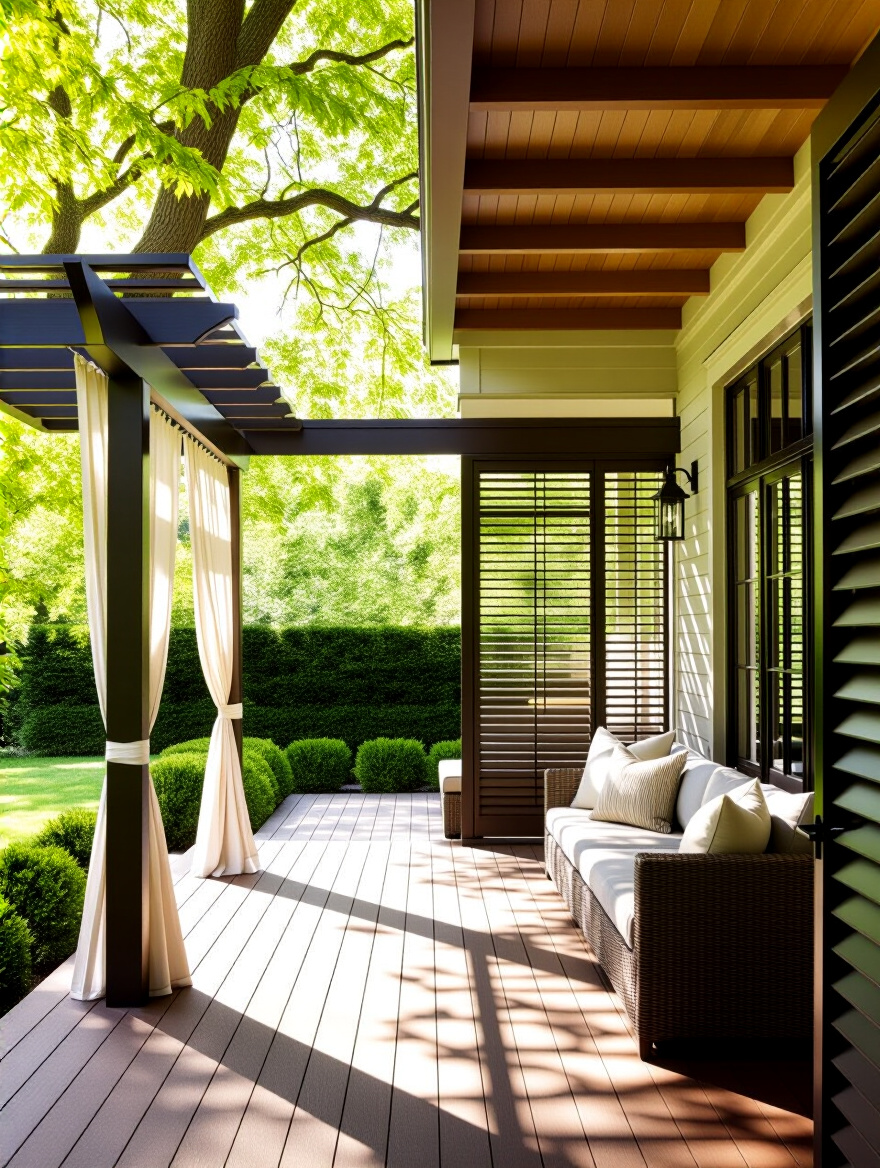
The same goes for wind. Is there a corner of your yard that acts like a wind tunnel? You’ll want to avoid putting your main seating area right in its path. Maybe a strategically placed wall of shrubs or a pretty privacy screen could create a calm little pocket. On the flip side, if you live somewhere hot, you’ll want to invite a gentle cross-breeze in. It’s all about working with nature instead of fighting it. This is how you create a porch that feels like a perfect little microclimate, your personal sanctuary from the elements.
Okay, just one more bit of “official” business to get through, and then it’s on to the fun structural stuff!
5. Navigate Local Zoning Codes and Permit Requirements Smoothly
I know, I know. Paperwork, rules, regulations… it’s the definition of dull. But can I tell you a little horror story? A friend of mine built the most beautiful porch, but they didn’t check the setback rules—how far the structure has to be from the property line. A neighbor complained, and they had to tear down a portion of it. It was expensive, frustrating, and completely avoidable. Please, don’t let this be you!
Before you do anything else, pop over to your local town or city building department’s website, or just give them a call. Every town has its own set of rules about how big a porch can be, how close it can get to your neighbor, and what kind of foundations are required. It seems like a pain, but it’s really about safety and being a good neighbor. Think of it as your project’s insurance policy. Getting this handled upfront ensures your beautiful new space is safe, legal, and won’t cause any expensive headaches down the road.
Structural & Spatial Decisions: Building a Solid and Functional Foundation
Alright, the planning is done! Now we get to talk about the real bones of your porch. These are the big choices that will ensure your outdoor retreat is sturdy, spacious enough for your family, and will last for years and years of morning coffees and evening chats.
6. Select Durable Decking Materials for Longevity and Aesthetic Appeal
The floor of your porch is its foundation for comfort. Think about walking out there in your bare feet first thing in the morning. You don’t want to worry about splinters! While traditional wood is beautiful, it can also mean a yearly ritual of sanding and staining. If you’re a busy parent like me, that might be a weekend you just don’t have to spare.
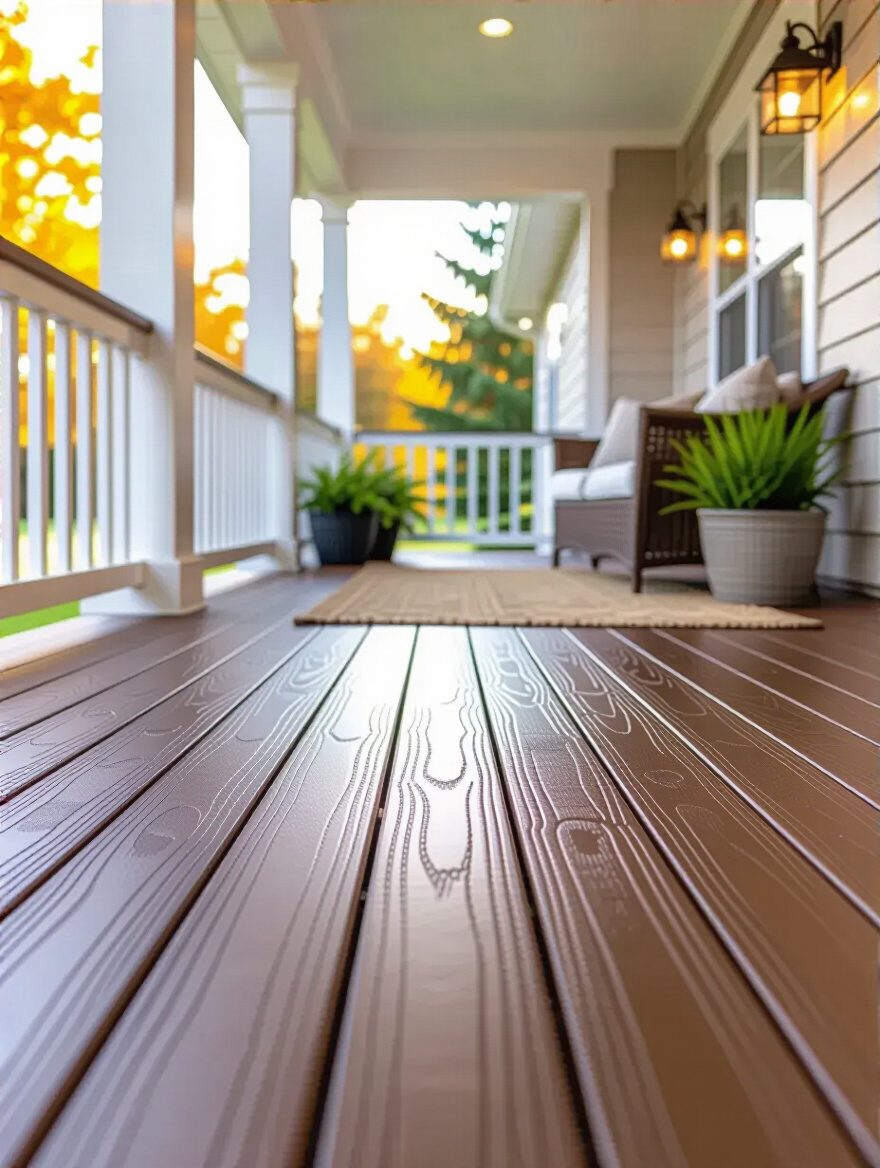
This is where it pays to look at some of the amazing new materials out there. Composite and PVC decking have come such a long way. They look incredibly realistic, come in a huge range of colors, and the best part? You just have to hose them down. They won’t warp, rot, or fade like wood can. While they might cost a bit more upfront, think about the long-term savings in time, money, and sanity. A friend of mine chose a lighter-colored composite for her sunny porch, and it’s so much cooler on her kids’ little feet in the summer. It’s about choosing a material that serves your lifestyle, not one that adds another thing to your to-do list.
Now that we have the floor down, let’s figure out how big this beautiful space should be.
7. Design Your Porch Dimensions for Ideal Proportional Balance
Have you ever seen a porch that looks way too tiny for the house, like a little postage stamp, or one that’s so massive it completely takes over? Getting the size and proportions just right is key to making it feel balanced and beautiful. The goal is “just right,” like Goldilocks. It needs to be big enough to be functional but scaled appropriately so it looks like it belongs.
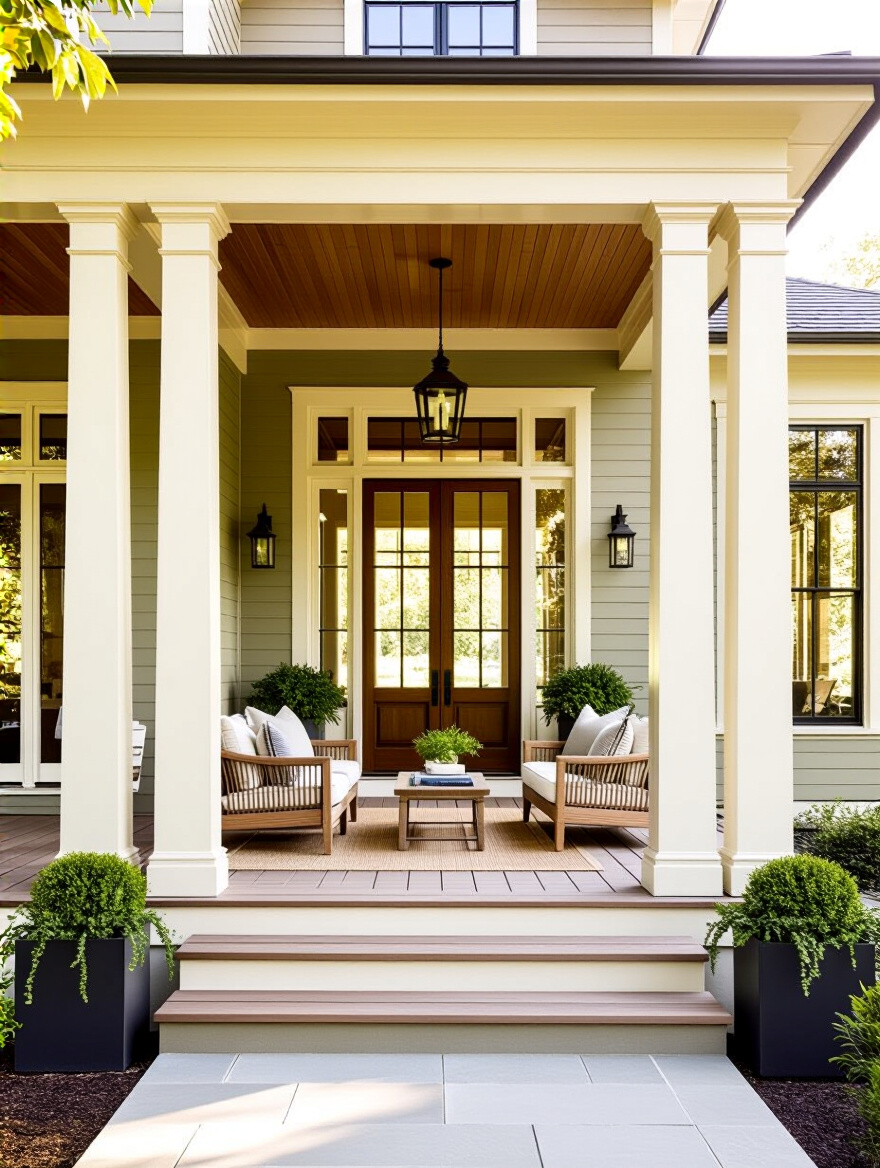
My favorite trick is to mock it up in real life. Forget complicated architectural software. Go outside with a roll of painter’s tape or even just some string and lay out the proposed dimensions on the ground. Then, grab some cardboard boxes to stand in for your furniture. Can you walk around the “sofa” and “chairs” easily? Do you have at least three feet of walkway to move around? A porch for lounging really needs to be at least 8 feet deep to feel generous and not cramped. If you want a dining table, you’ll need even more space. Playing with it in your own yard will give you a much better feel for the space than any drawing ever could.
With the footprint decided, it’s time to think about what’s holding it all up.
8. Choose the Right Foundation Type for Optimal Stability and Drainage
Okay, this part isn’t glamorous, but it is so, so important. The foundation is what keeps your porch from sinking, shifting, or heaving when the ground freezes and thaws. You can have the most beautiful porch in the world, but if it’s sitting on a shaky foundation, it’s not going to last. This is one area where you absolutely should not cut corners.
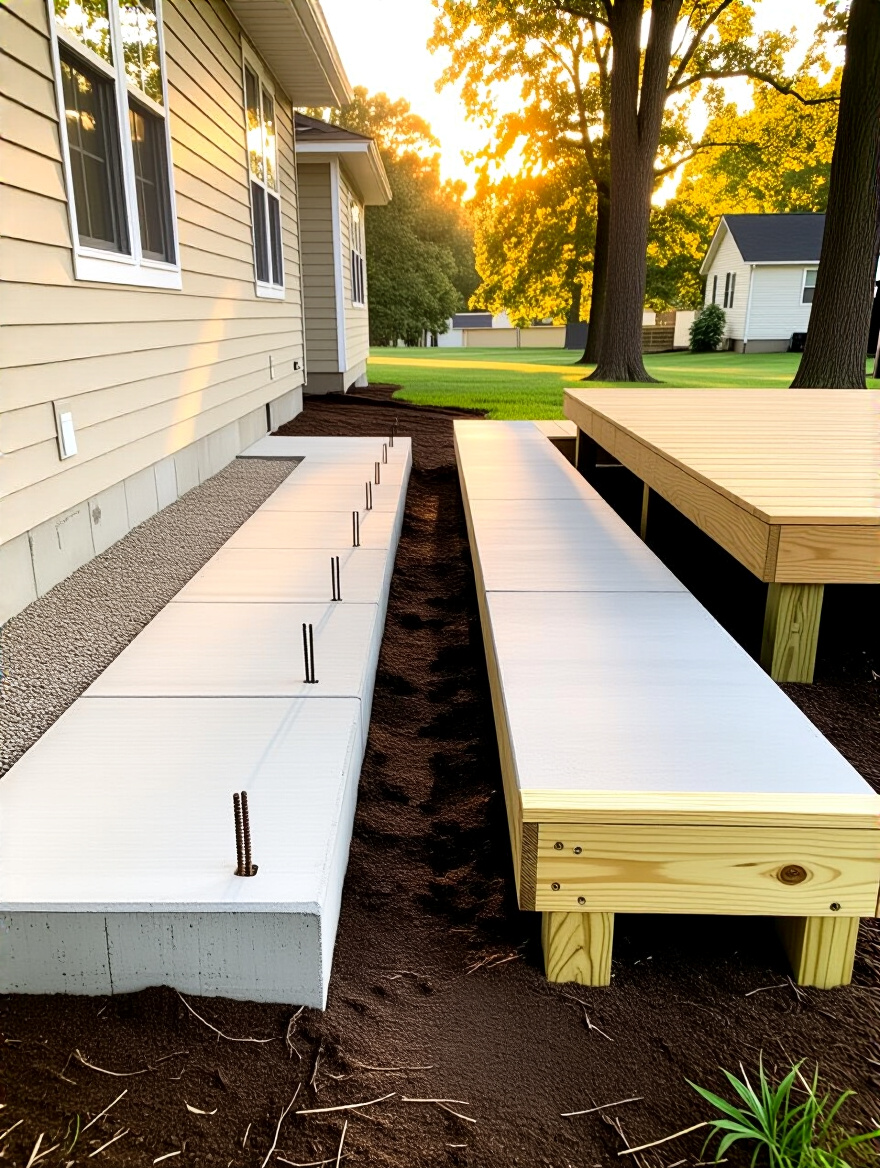
The right choice depends on your climate and soil. In places with cold winters, you’ll need footings that go below the frost line to prevent movement. On a sloped lot, you might need a different approach than on a flat one. This is also the time to think about drainage, ensuring water flows away from your house, not toward it. Honestly, this is the perfect moment to lean on the expertise of a good contractor. They’ll know the local codes and what works best in your area, giving you the peace of mind that your beautiful investment is built to last a lifetime.
Next, we’ll look up and add a “ceiling” to our outdoor room.
9. Integrate a Roof Style that Complements Your Home’s Silhouette
The roof is what officially turns a deck into a porch, transforming it into a true outdoor room. It provides shelter, defines the space, and has a huge impact on your home’s Curb Appeal. Just like the porch itself, the roof needs to speak the same architectural language as your house. It should look like it was part of the original plan, not a clunky addition.
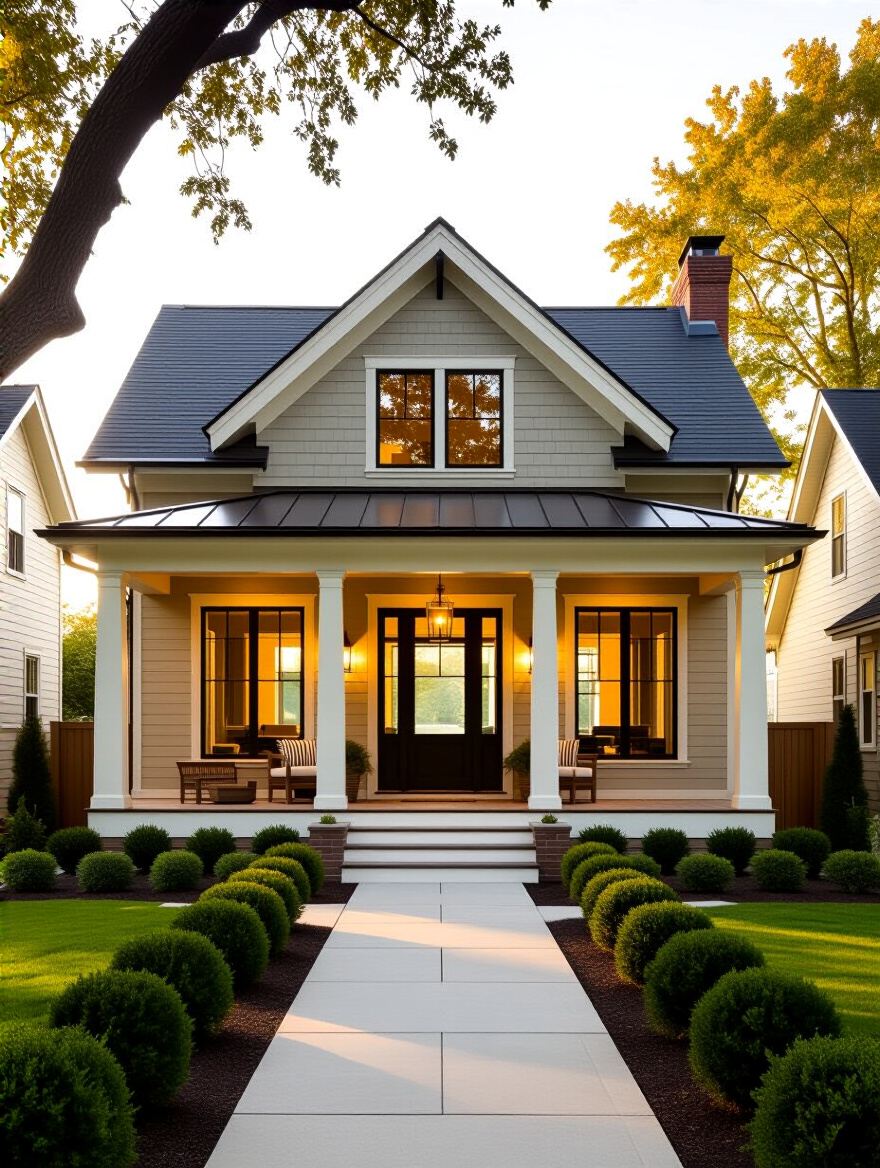
Take a look at your home’s main roof. Is it a simple slope (a shed roof)? Or does it have a peak (a gable roof)? The easiest way to create harmony is to mimic that same pitch and style on the porch. Matching the roofing material—whether it’s shingles or metal—is another key to making it look seamless. One of my favorite cozy tricks is to install a beadboard ceiling on the underside of the porch roof and paint it a very pale, soft blue, often called “haint blue” in the South. It’s a historical touch that is said to ward off spirits, but it also just feels wonderfully serene and subtly mimics the sky.
Now, for those of us who battle with bugs, let’s talk about the magic of screening.
10. Explore Screening Options for Enhanced Comfort and Pest Protection
I live in an area where mosquitoes can ruin a perfectly lovely summer evening in about five minutes. For many of us, screening isn’t a luxury; it’s a necessity if we ever want to relax outside. A screened-in porch is the ultimate hybrid space—you get all the breezes and sounds of the outdoors without any of the uninvited six-legged guests. It means you can eat dinner without swatting at flies and read a book at dusk without getting eaten alive.
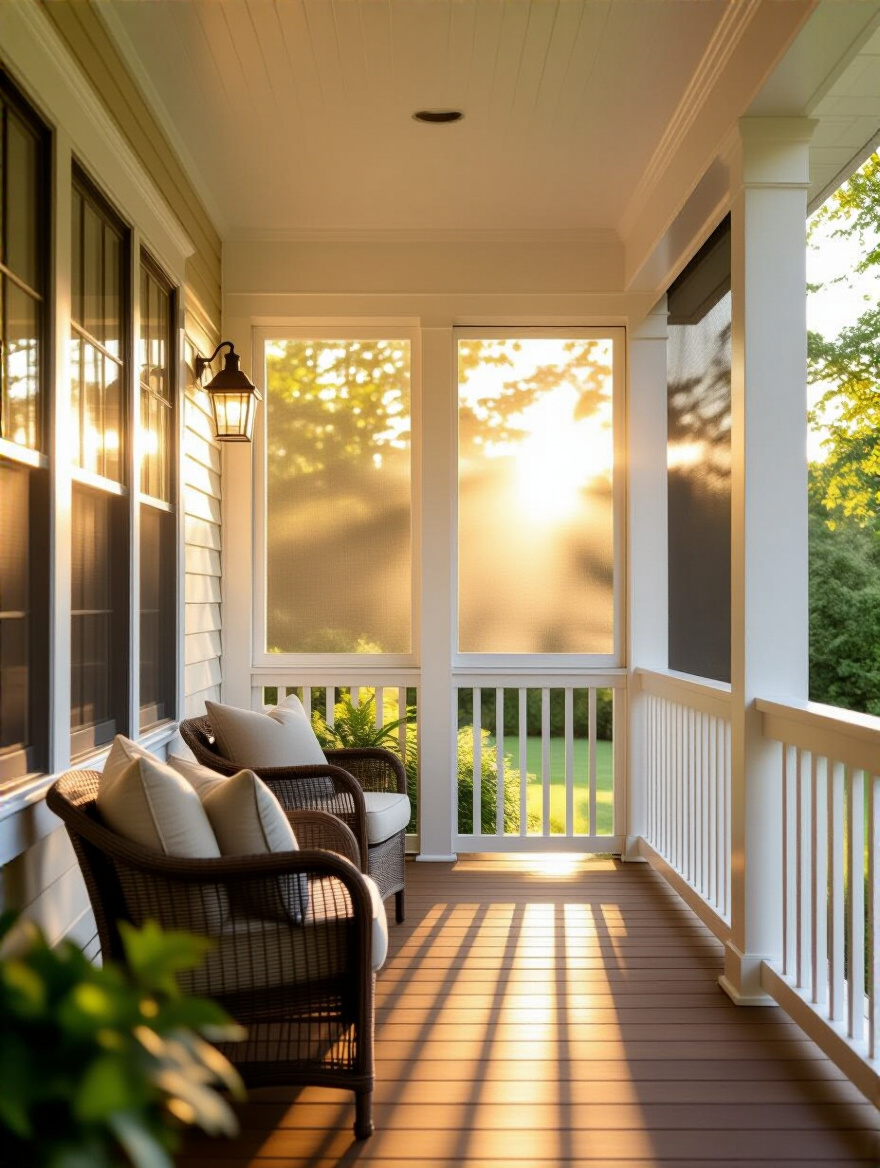
The great news is, you have options. You can go for traditional fixed screens, or you could look into retractable screens that disappear with the touch of a button, giving you the best of both worlds. There are even systems with vinyl window panels that can turn your screened porch into a three-season room, protecting you from pollen in the spring and chilly winds in the fall. A screened-in porch is a game-changer for so many families, extending the time you can spend enjoying your home immensely.
Aesthetic Enhancements: Creating Beauty, Comfort & Ambiance
The bones are in place! Now comes the truly fun part—dressing up your porch and infusing it with personality, warmth, and that magical, cozy glow. This is where we turn a well-built structure into a space that feels like a warm hug.
11. Implement Layered Lighting for Safety, Ambiance, and Evening Use
Lighting is the secret weapon for creating ambiance. One single, harsh overhead light—what I call the “bug zapper light”—is a mood-killer. The key is to layer your lighting, just like you would in a living room. You need three types: ambient light for overall glow, task light for specific activities, and accent light for a touch of magic.
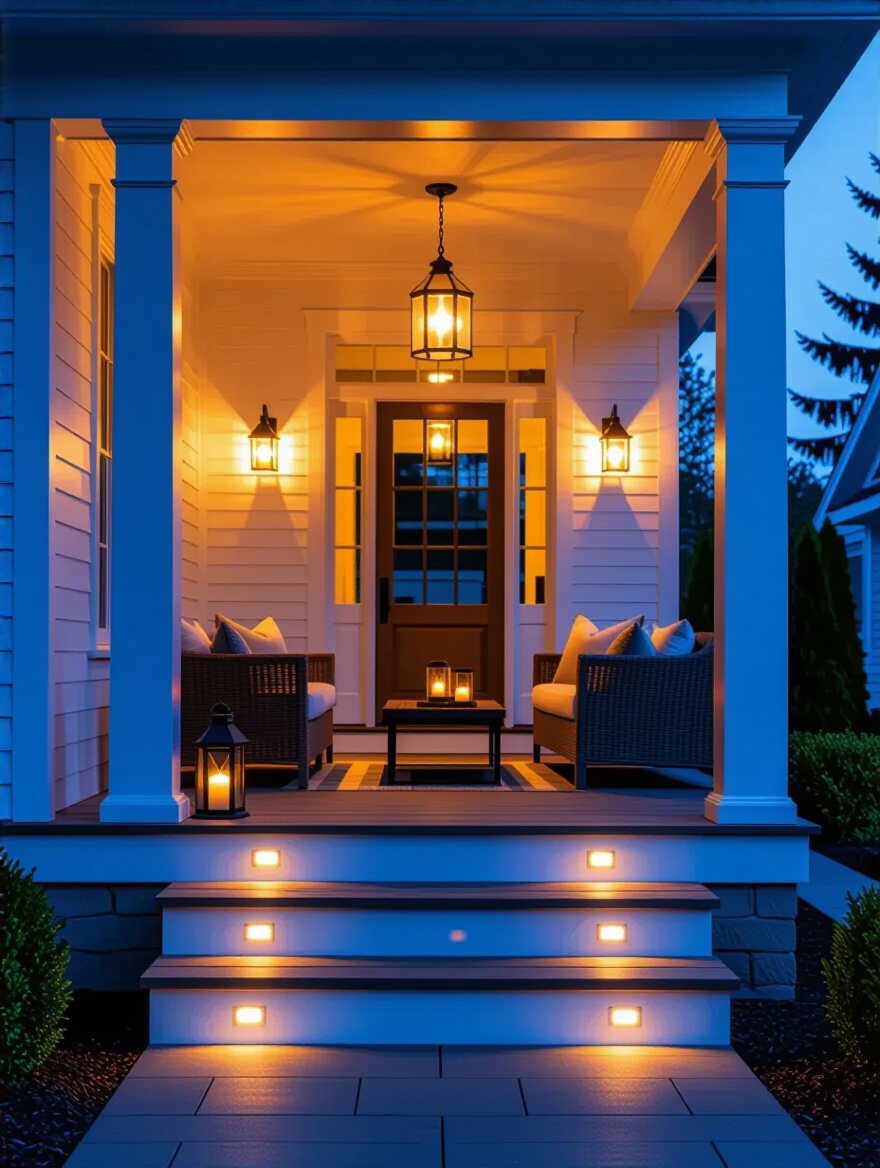
For ambient light, think about a beautiful overhead fixture or some recessed can lights—all on a dimmer switch! A dimmer is non-negotiable; it lets you go from bright for cleanup to a soft glow for relaxing. For task lighting, a couple of stylish wall sconces on either side of the door provides a warm welcome and helps you see the keyhole. And for that magical accent layer? Nothing beats the twinkle of string lights. Drape them along the ceiling or around the railings. Add a few solar-powered lanterns in the corners or uplights on nearby plants. This mix of light sources makes the space feel sophisticated, cozy, and utterly enchanting after dark.
With the mood set, let’s talk about the most important element for comfort: the furniture.
12. Select Comfortable, Weather-Resistant Furniture to Define Zones
This is my absolute favorite part. The right furniture is what will beckon you outside and convince you to stay. My number one rule? It has to be as comfortable as your indoor sofa. If it’s not, you won’t use it. Look for deep seats, plush cushions, and materials built to last outside. Gone are the days of scratchy, plastic-feeling outdoor fabrics. Modern performance fabrics like Sunbrella are a lifesaver—they resist fading, water, and stains. I know this firsthand; my kids have tested our outdoor cushions with everything from grape juice to melted popsicles, and they still look amazing.
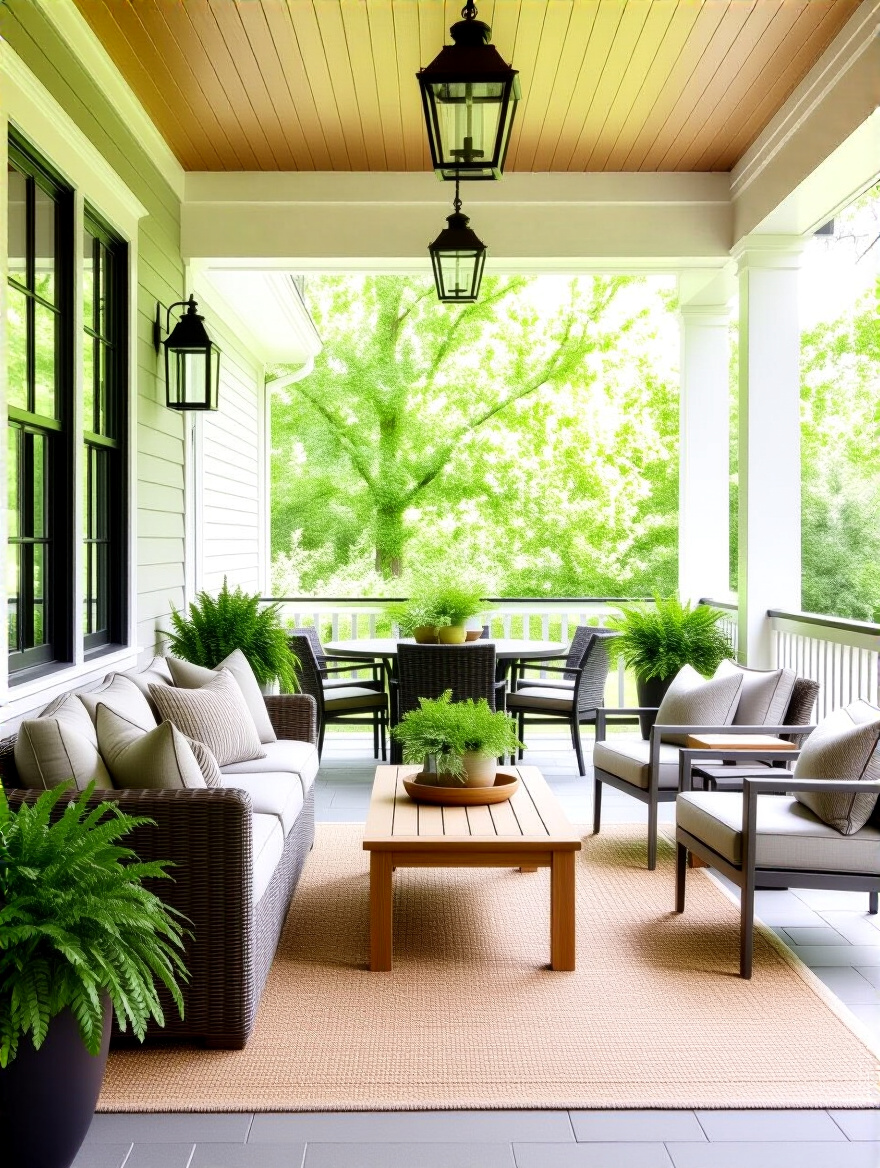
Think about creating zones with your furniture, just like in an open-concept living space. A comfy sofa and a couple of armchairs clustered around an outdoor rug create an intimate conversation area. A small bistro table and two chairs tucked into a corner can be a perfect spot for morning coffee. Using furniture to define these different activity zones makes even a small porch feel more spacious and versatile, inviting your family to come out and live life on the porch.
And we’ll tie all that furniture together with a beautiful color scheme.
13. Choose a Color Palette that Harmonizes with Your Home’s Exterior
Color is the thread that ties everything together. The best approach for a porch is to pull colors directly from your home’s exterior to create a seamless, harmonious look. Look at the color of your siding, your trim, your front door, and any brick or stone you have. These are your clues. You can create a beautiful palette by using your home’s trim color for the porch railings and columns, and then choosing a floor color that complements the siding or stone.
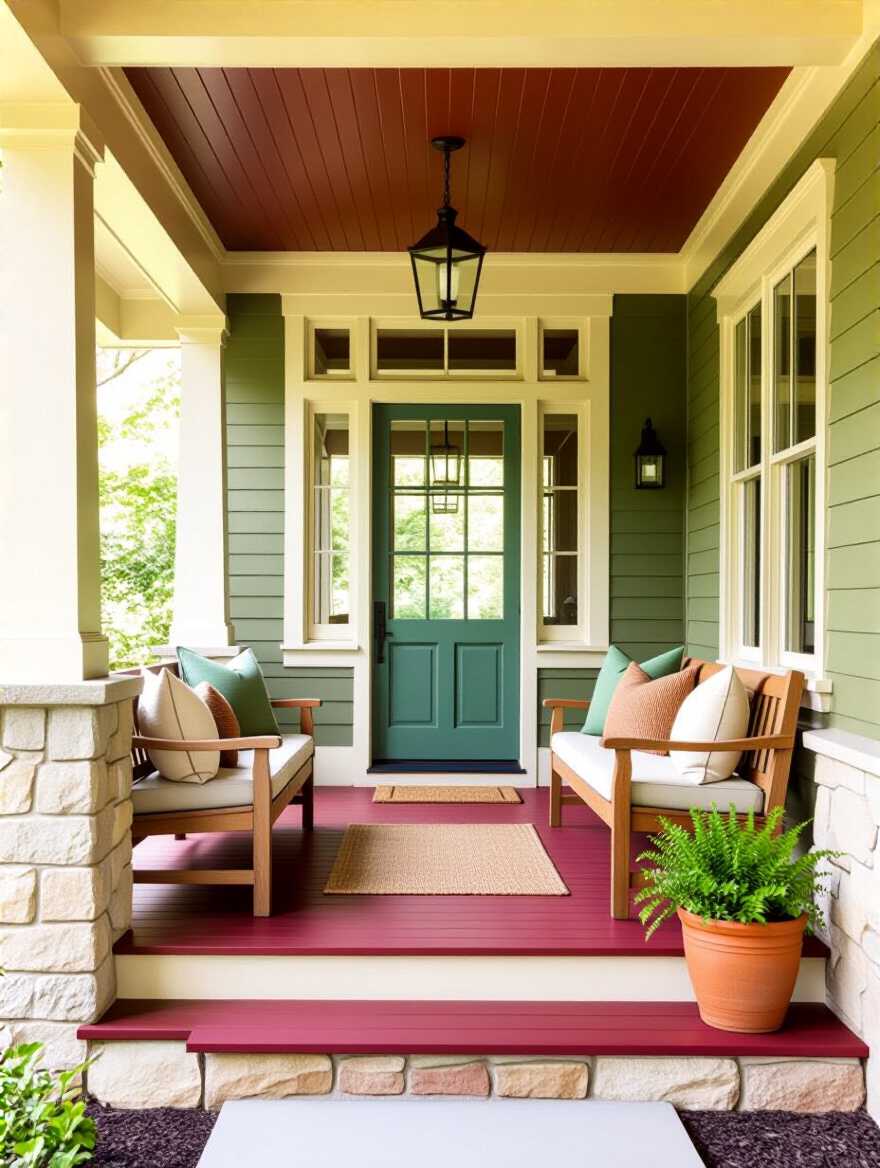
Your accent color—the one for your pillows, planters, and front door—is where you can have some fun and inject personality. It could be a sunny yellow, a calming sea blue, or a cheerful coral. My advice is to keep the big, permanent things fairly neutral and save the bold colors for the accessories you can easily change out. This gives you the flexibility to refresh your porch’s look with the seasons or whenever the mood strikes, without having to repaint the whole thing.
Now let’s soften all those hard surfaces with a little bit of green.
14. Integrate Landscaping Elements to Frame and Soften the Space
Landscaping is what nestles your porch into its surroundings and makes it feel like it truly belongs to the garden. It’s the finishing touch that blurs the lines between your home and nature. You don’t have to be a master gardener to make a big impact. Foundation plantings like evergreen shrubs or hydrangeas along the base of the porch can soften the hard edges and anchor it to the ground.
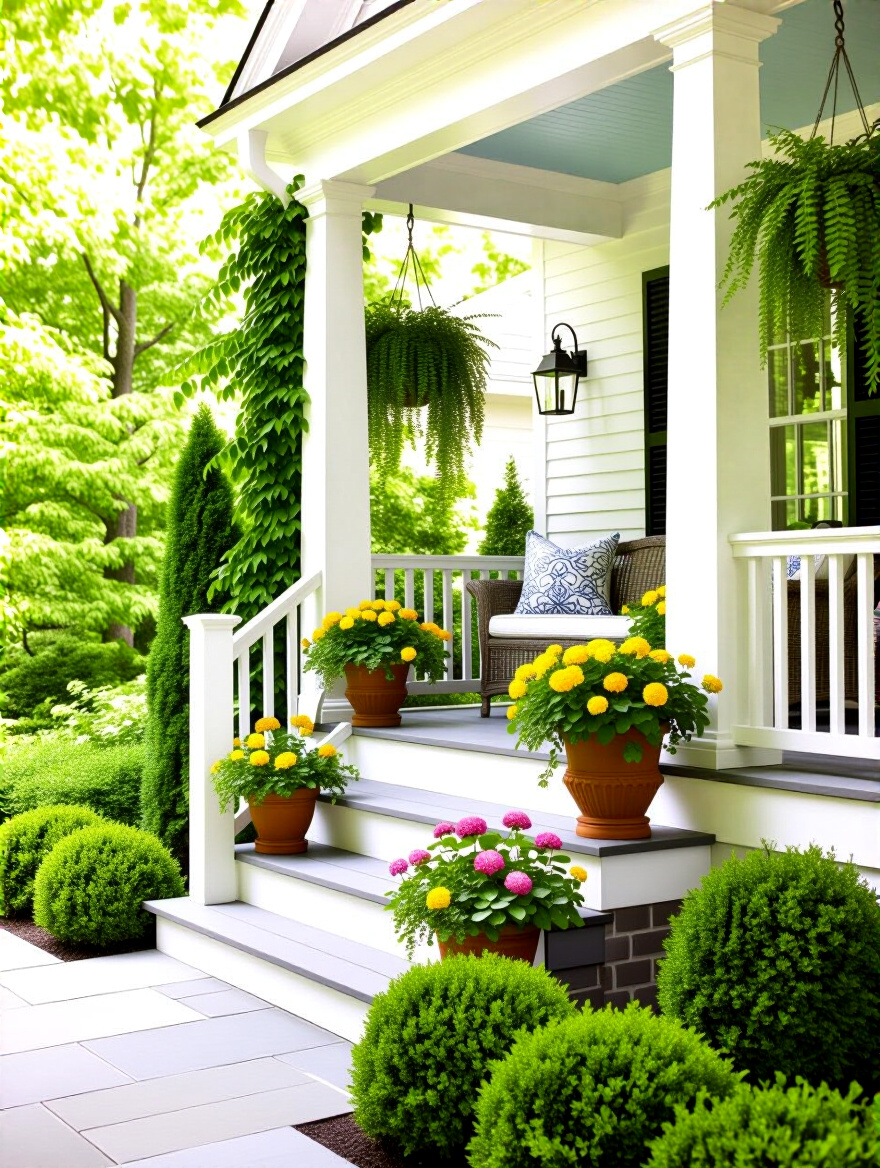
Don’t forget the power of containers! A few beautiful pots filled with colorful annuals on the steps or in the corners can add so much life and charm. If you have porch columns, a climbing vine like clematis or jasmine can add a touch of romance and a heavenly scent. Landscaping provides privacy, can add a bit of shade, and surrounds you with beauty. It’s what transforms your porch from a structure into a true oasis.
Finally, let’s add those little touches that make the space uniquely yours.
15. Add Personal Touches with Thoughtful Decor and Textiles
This is the final, joyful layer—the one that tells your family’s story. Just like in your living room, textiles are key to coziness. An outdoor rug instantly defines a seating area and feels wonderful underfoot. A basket of soft, snuggly throws invites guests to linger on a cool evening. And pillows—oh, the pillows! They are the easiest way to add color, pattern, and of course, comfort.
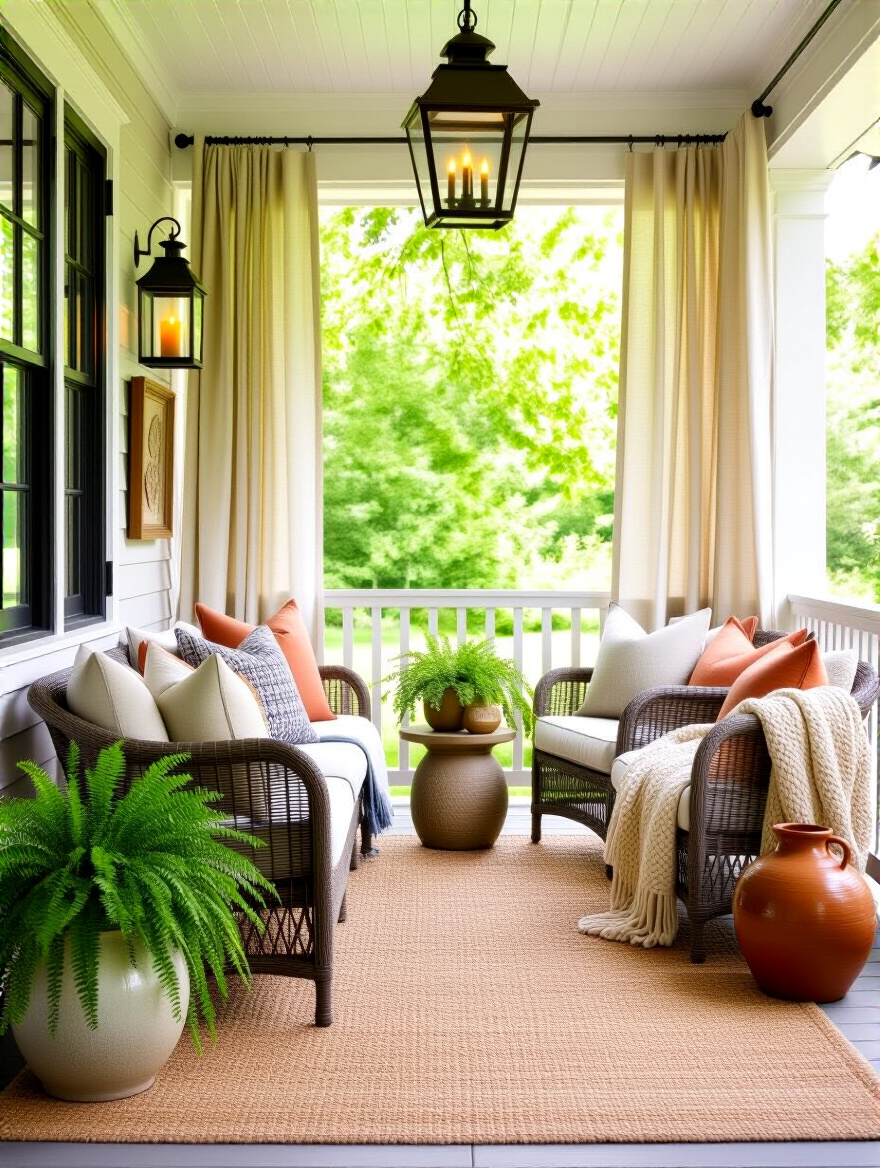
Beyond textiles, look for decor that has meaning to you. It could be a set of pretty ceramic lanterns, a piece of outdoor-rated wall art, or even a collection of smooth stones from a family vacation. One of my clients hung a beautiful, rustic wooden sign with their family’s name on it, and it immediately made the porch feel more personal and welcoming. These are the little details that elevate the space from “designed” to “dearly loved.”
Durability & Smart Solutions: Maximizing Value and Long-Term Enjoyment
We’ve created a beautiful, cozy space, and now we want to make sure it lasts and is as effortless to enjoy as possible. This is all about the smart choices that protect your investment and make your life easier, so you can spend less time working on your porch and more time living on it.
16. Ensure Proper Drainage Solutions to Protect Your Porch Structure
We touched on this in the planning stage, but it’s so critical it’s worth revisiting. Water is the number one enemy of any outdoor structure. Proper drainage is your porch’s silent guardian, protecting it from rot, mildew, and foundation damage. The most important thing is making sure that water flows away from your house. This means ensuring the ground around the porch slopes away from it, and that your gutters and downspouts are clean and directing water far from the foundation.
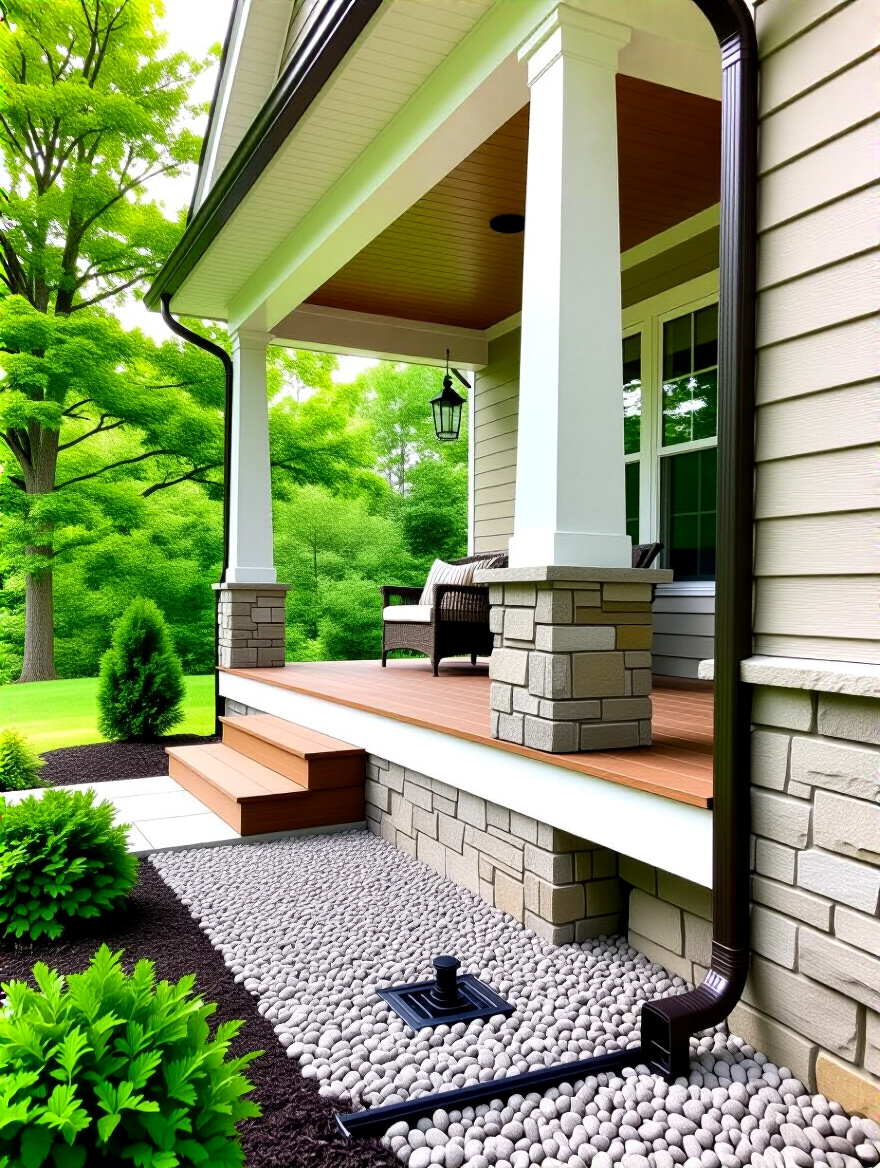
For the porch floor itself, especially if it’s unsheltered, there should be tiny gaps between the deck boards to allow rain to drain through instead of pooling on top. If water is allowed to sit against your house or around the support posts, it can cause devastating and expensive damage over time. It’s the least glamorous part of porch design, but getting your water management right from the start is the key to a long and happy life for your outdoor oasis.
And speaking of a long and happy life, let’s choose materials that make that a breeze.
17. Plan for Low-Maintenance Materials to Minimize Future Upkeep
As a busy mom, my goal for any home project is “less work, more joy.” Choosing low-maintenance materials is one of the single best gifts you can give your future self. It’s the difference between spending a sunny spring weekend sanding and staining your porch floor, or spending it relaxing on your porch with a lemonade. It’s a no-brainer for me!
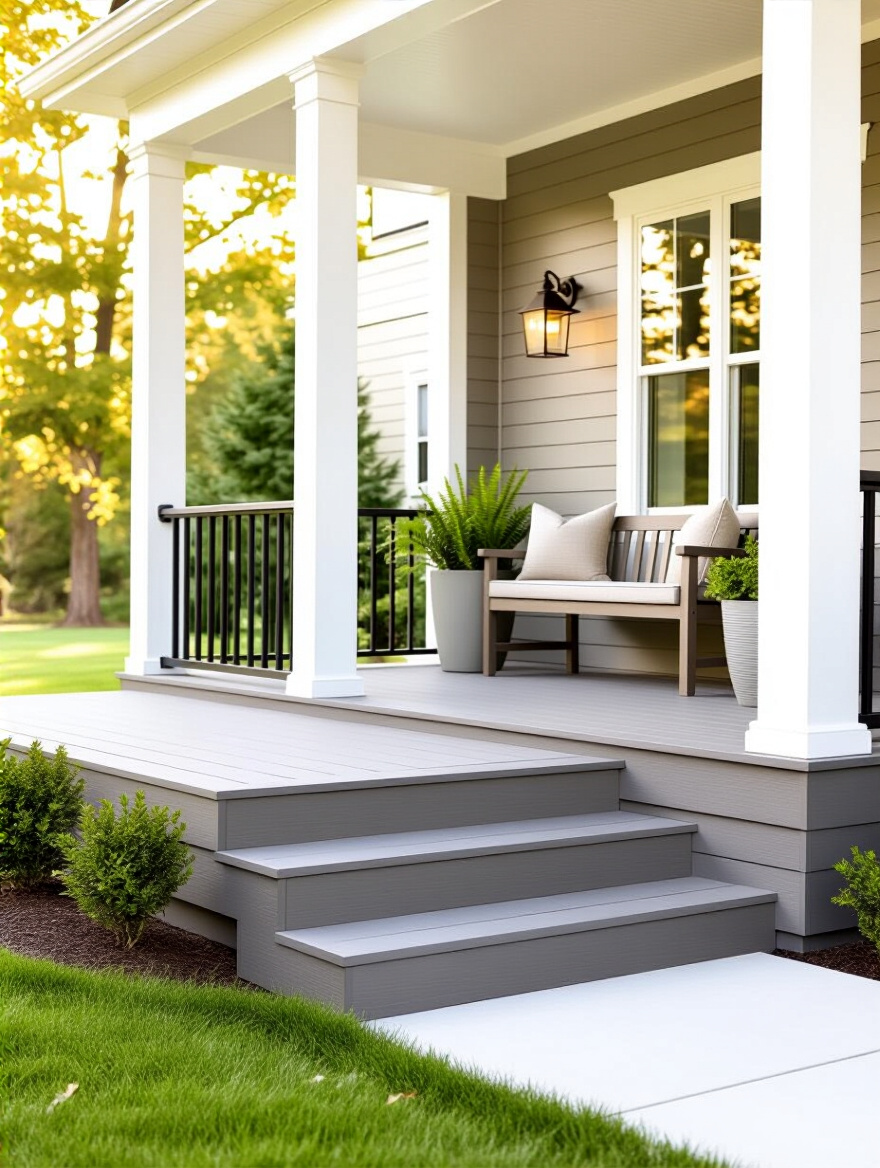
Think beyond just the decking. Railings now come in materials like aluminum and vinyl that never need painting. Columns can be made from fiberglass or cellular PVC that look like classic wood but won’t ever rot or get eaten by termites. While these materials can have a higher initial cost, the long-term savings in both money and your precious free time are immense. You’re not just building a porch; you’re buying back your weekends for years to come.
Next, let’s bring some modern convenience into our cozy retreat.
18. Incorporate Smart Home Technology for Enhanced Convenience
Smart home technology isn’t just for inside the house anymore. Bringing a few clever devices onto your porch can make it so much more convenient and enjoyable. Imagine telling your smart speaker to turn on the string lights and play your favorite “chill-out” playlist as you walk outside. Or having your outdoor ceiling fan turn on automatically when the temperature hits a certain point. It feels like a little bit of everyday magic.
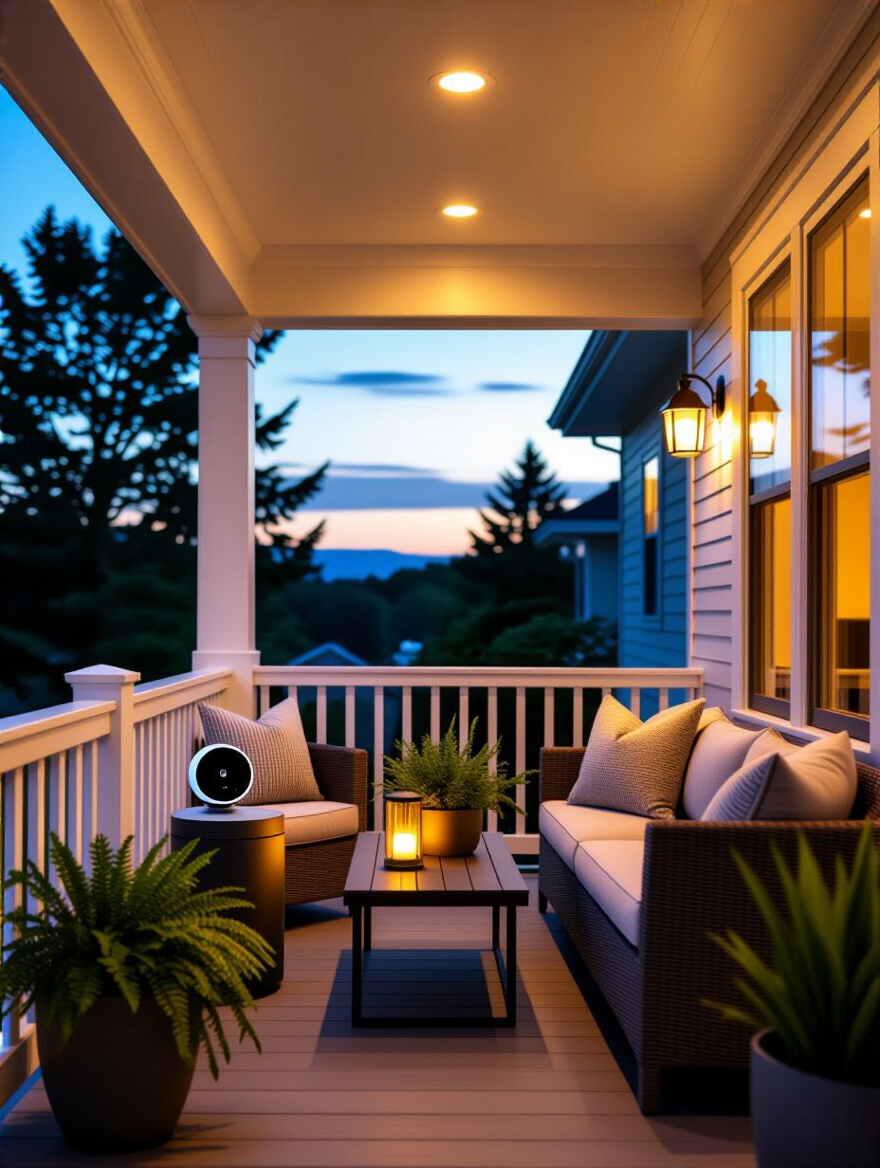
You can also enhance security with a smart doorbell camera or motion-activated lights, giving you peace of mind. Outdoor-rated smart plugs are fantastic for controlling holiday lights or a tabletop fountain without ever having to unplug them in the rain. Just be sure to choose devices specifically made for outdoor use and ensure your Wi-Fi signal is strong enough to reach the porch. These simple tech upgrades can take your porch from great to absolutely effortless.
And for true Year-round enjoyment, let’s think about controlling the temperature.
19. Add Seasonal Comfort with Outdoor Heating or Cooling Systems
What if you could enjoy your porch on a crisp autumn evening or a warm summer afternoon? You can! Integrating heating or cooling elements is the key to stretching your porch season by months. For cooler weather, there are so many great options. A classic outdoor fireplace or a fire pit table becomes a natural gathering spot for making s’mores and memories. Wall- or ceiling-mounted electric infrared heaters are incredibly effective, providing instant, targeted warmth without taking up any floor space.
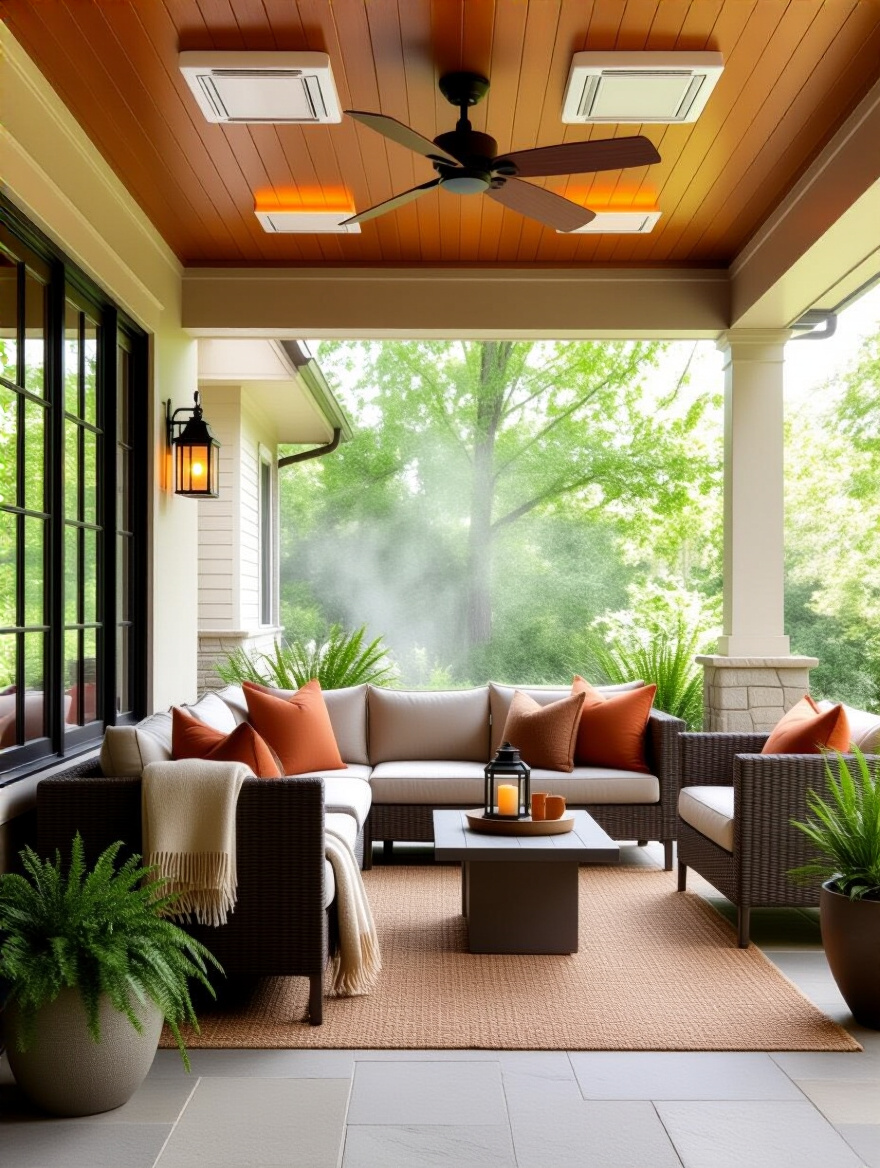
In hot climates, a good quality outdoor ceiling fan can make a world of difference by creating a gentle breeze. Misting systems are another fantastic option for dropping the temperature on a sweltering day, creating a resort-like feel right at home. Adding these elements turns your porch from a “perfect weather only” space into a reliable, four-season retreat. It’s an investment that pays you back every time you’re able to sit outside when you otherwise would have been stuck indoors.
Last but not least, let’s give your home that one-of-a-kind finishing touch.
20. Design Custom Railings or Columns for Unique Curb Appeal
This is the jewelry for your home. While there are plenty of great off-the-shelf options, designing custom railings or columns is what can truly set your home apart and give it a powerful dose of personality. It’s a chance to make a real architectural statement that reflects your personal style.
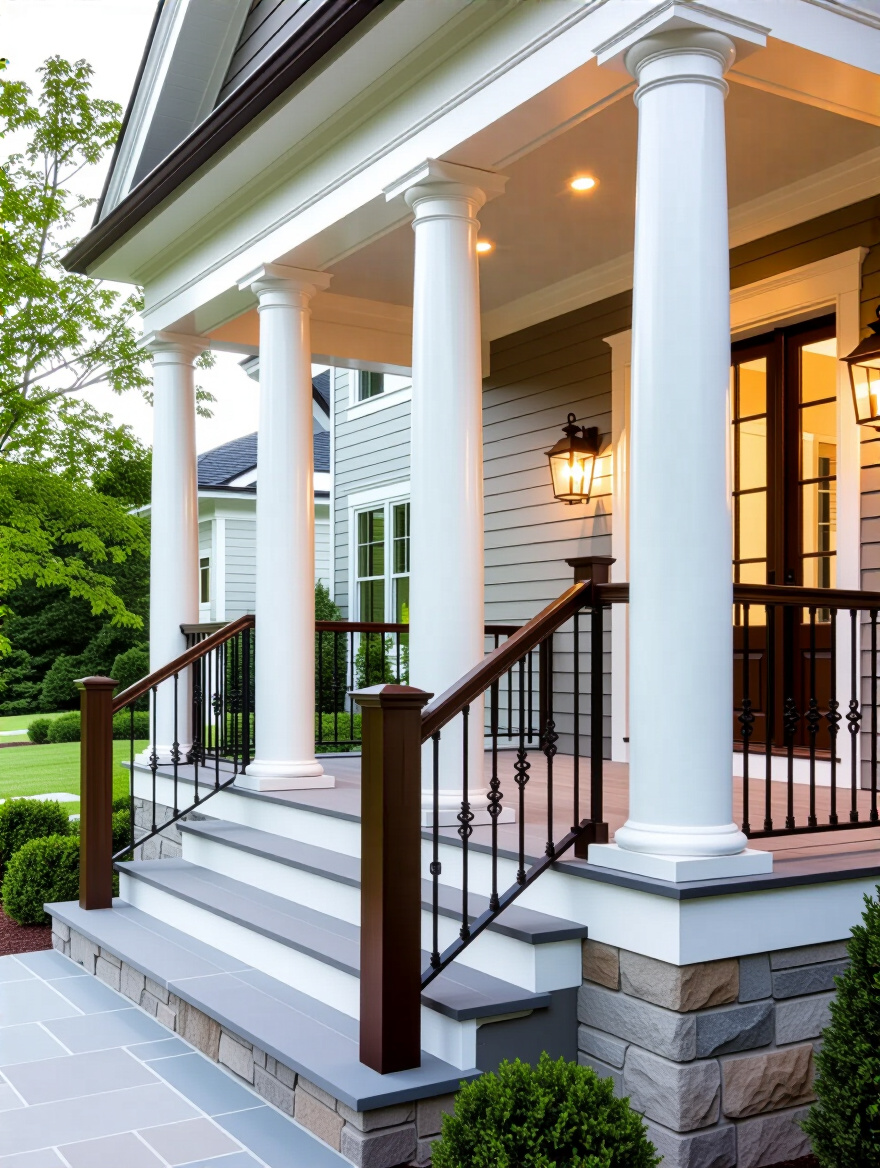
Imagine beautifully crafted wooden railings with a unique baluster design that echoes a detail from inside your home. Or perhaps a sleek, modern look with stainless steel cables and a rich Ipe wood handrail. Customization allows you to get the proportions and details exactly right for your home’s scale and style. It’s the kind of thoughtful, high-quality detail that elevates the entire look of your home and creates undeniable curb appeal, making your porch a true masterpiece.
Conclusion
See? Creating your dream porch is a journey of a thousand little thoughtful choices, and every single one is worth it. It’s about so much more than wood and nails; it’s about carving out a space for your family to connect, to rest, and to just be. From that first moment of deciding how you’ll live out there to layering on the final cozy pillows, you are building the next backdrop for your family’s favorite memories.
Don’t feel like you have to do it all at once. Start with a solid plan, and maybe just a couple of comfortable chairs. You can add the layers—the rug, the lighting, the planters—over time. The most important thing is to begin. Let these ideas inspire you to look at your own porch not just as it is, but as what it could be: the true heart of your home, waiting for you to come and sit for a while.
